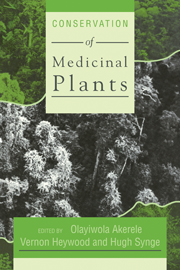Book contents
- Frontmatter
- Contents
- Contributors
- Preface
- Acknowledgements
- The Chiang Mai Declaration
- Introduction
- 1 Medicinal Plants: Policies and Priorities
- 2 The Joint IUCN-WWF Plants Conservation Programme and its Interest in Medicinal Plants
- The Issue of Medicinal Plants
- Science, Industry and Medicinal Plants
- Techniques to Conserve Medicinal Plants
- Policies to Conserve Medicinal Plants
- Experiences from Programmes to Conserve Medicinal Plants
2 - The Joint IUCN-WWF Plants Conservation Programme and its Interest in Medicinal Plants
Published online by Cambridge University Press: 07 September 2010
- Frontmatter
- Contents
- Contributors
- Preface
- Acknowledgements
- The Chiang Mai Declaration
- Introduction
- 1 Medicinal Plants: Policies and Priorities
- 2 The Joint IUCN-WWF Plants Conservation Programme and its Interest in Medicinal Plants
- The Issue of Medicinal Plants
- Science, Industry and Medicinal Plants
- Techniques to Conserve Medicinal Plants
- Policies to Conserve Medicinal Plants
- Experiences from Programmes to Conserve Medicinal Plants
Summary
Introduction
Living resource conservation for sustainable development is the main goal of the world's largest, independent conservation organizations, the International Union for Conservation of Nature and Natural Resources (IUCN) and the World Wide Fund for Nature (WWF).
Around the world, over-exploitation of living resources takes place in order to meet short term needs, but more often than not the process destroys exactly those resources on which the welfare of millions of people depend in the long term. This lack of sustainable utilization is, in fact, widening the gap between rich and poor countries in the world, because there is a clear relation between conservation and development: they operate in the same global context, and the underlying problems that must be overcome if either is to be successful are identical (IUCN, UNEP & WWF, 1980).
Most tropical countries are developing countries with grave economic, social and perhaps political problems. In these countries, an accelerating loss of biological diversity – plants, animals and microorganisms – leads to a breakdown of ecological processes and life-support systems. These problems affect developing and developed countries alike, and international action and collaboration are needed to find and implement solutions.
The Case of Tropical Forests
The Food and Agriculture Organization of the United Nations (FAO) has estimated that about 56% closed tropical forest remained on earth in 1980; 44% closed tropical forest, or rain forest, had already disappeared during the period 1940 to 1980 (Lanly, 1982). The annual deforestation was estimated to be about 75,000 km2, but this figure included rain forests only.
- Type
- Chapter
- Information
- Conservation of Medicinal Plants , pp. 13 - 22Publisher: Cambridge University PressPrint publication year: 1991
- 5
- Cited by



